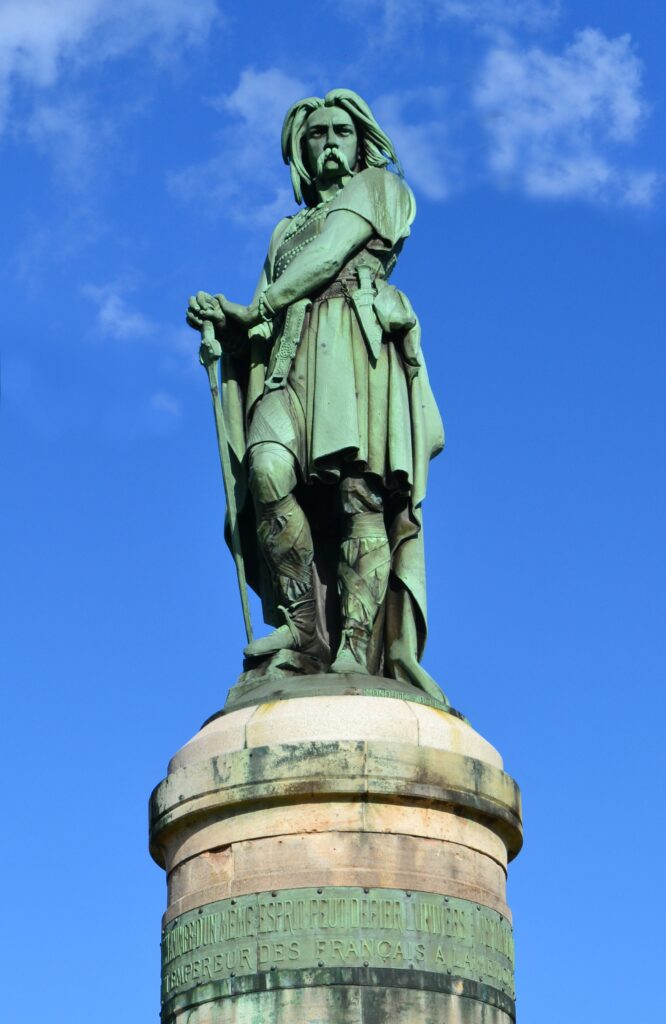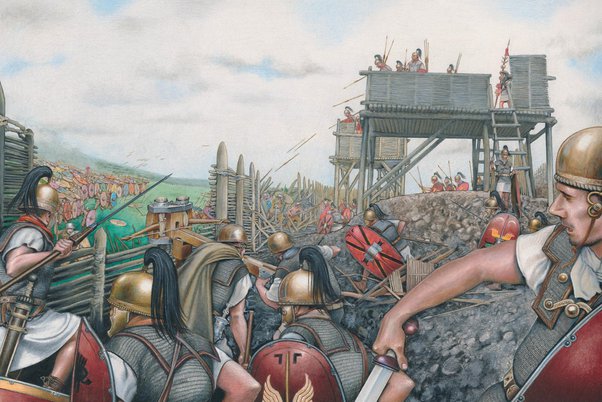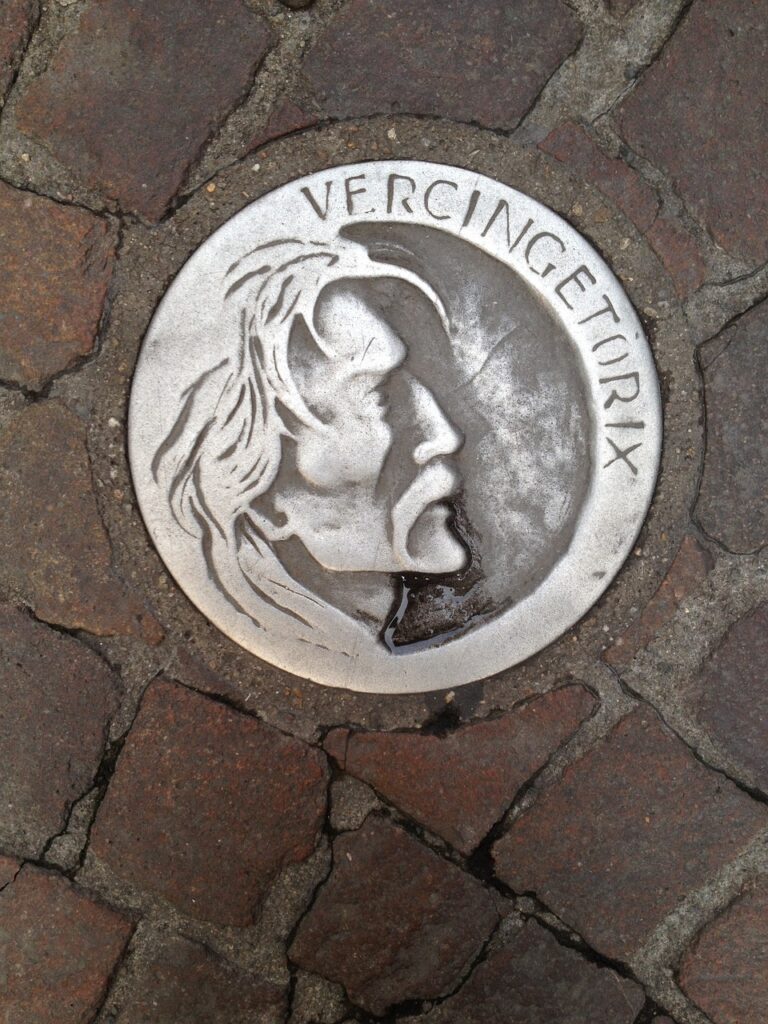

Vercingetorix can be mainly related to Rome’s public enemy during the Gallic War. The Gallic War itself considered to be one of many important events for the Roman Republic. The result of this conflict directly influences shaping Western European countries. In addition, Rome’s victory during the Roman-Gallic wars strengthened Julius Caesar’s name and status to be one of the best Roman generals and the world’s military figures.
Despite his success during the Gallic conquest, the Romans under Julius Caesar met their biggest adversary, A Gallic king named Vercingetorix. His name echoes throughout the land of Gallia and inspires the Gallic people to fight for their independence. Against all odds, he led his people and nearly succeeded in repelling the Roman Conquest of Gallia.
Historical Context of Roman-Gallic Wars

The Romans and the Gallic people first encountered in 509 BC. During this time, the Gauls started to trouble the new Roman Republic by raiding and pillaging the new Roman settlements. The central conflict began when the Gallic tribes captured and sacked the city of Rome in 390 BC. This traumatizing event will be the turning point for the Romans to prepare themselves better for the next 2 centuries.
Fast forward to 60 BC, Gaul was divided into 2 parts. The first part widely known as ‘Cisalpine Gaul’, which previously conquered and fell under Roman control. The second part known as ‘Transalpine Gaul’, located in modern-day France. The Romans considered this region a barbarian region and the Romans have repeatedly failed to invade this region.
Caesar’s provocation of war
Like all Roman generals, Julius Caesar was very eager to lead a military campaign and conquer new places. Caesar saw a great opportunity and planned to conquer ‘Transalpine Gaul’. By doing so, Caesar will be able to gain fame, wealth, and to strengthen his position in the Roman political hierarchy.
However, Caesar needs to find a good reason to start a war. In 61 BC, a new opportunity arises when a group of people from Switzerland were migrating to Southern Gaul. For them to reach their destination, the Helvetii from Switzerland had to pass through the Roman territories. These people must pass through the Aedui region, which is famously known as an important Roman ally.
As expected by Caesar, the Helvetians passed the territory of Aedui and raided their capital city, Bibracte. In response to this event, Caesar raised 2 legions and some auxiliaries along the way. With more than 25,000 legionary troops, Caesar quickly reinforced the Aedui people by defeating the Helvetians and another Germanic tribe known as Suebi.
These victories lead Caesar into the center of the Gaul territory. With everything that seems under his control, Caesar finally determine to capture the remaining region of Gallia with his legionary troops.
Who Was Vercingetorix?
Vercingetorix came from the Arveni tribe and rose to his prominence as the leader of Gallic resistance to the Roman Republic. His name has a powerful meaning, which known as “over-king of warriors”. The early life of Vercingetorix cannot be traced since it’s lacking proper documentation. However, his later life shows that Vercingetorix was known for his strategic genius, unbreakable spirit, and ability to unify the Gallic tribes.
The Arveni tribe considered to be one of the most powerful tribes in Gaul. This tribe’s habitat was located at Auvergne, Central France. Like his father, Vercingetorix’s father called Celtillus, was also famous for uniting Gallic tribes to resist the Romans. Eventually, Celtillus’ plan failed and his own people killed him for disagreement.
Vercingetorix’s Struggle On Roman Invasion of Gallia

After Caesar’s success against Helvetii and Suebi, he turned his full attention to Gallia. Over the next 8 years, he waged the famous Gallic wars between the Romans and Gaul. The people of Gaul scattered around modern-day France, Belgium, and some parts of Switzerland, Germany, and the Netherlands. However, these people were divided based on their tribes. Most of the time, these tribes battle against each other for territorial disputes and personal grievances.
For Caesar and the Romans, these circumstances considered by them as a big opportunity that facilitate further invasion. When the Romans began their invasion of Gaul, the Romans did not face a unified resistance, but a range of tribes with their own interest, ambition, and loyalty.
On the other hand, Vercingetorix driven by strategic calculation and personal ambition, decided to revolt against the Romans. He believed that the Romans were a big threat to the survival of the Gallic people. Vercingetorix deeply understands that the Romans will surely implement Roman custom, culture, tradition, and language if they able to conquer Gallia.
With more planning, he finally called the council of Gallic leaders. With his charisma and interpersonal skills, he was able to convince all the tribal leaders to unite under one banner. Not only that, these newly unified tribes chose Vercingetorix to be their king and pledged their allegiance to him.
Finally, for the first time, the Gallic tribes coordinate their military efforts under one single command. Vercingetorix executed the scorched-earth policy in order to deprive the Roman resources. Furthermore, he led a series of guerilla attacks against the Romans.
Siege of Avaricum
The first challenge for the unified Gaul occurred during the Roman siege to Avaricum. During the siege, Vercingetorix camped outside the city of Avaricum. During the siege, Vercingetorix was planning to abandon his camp and outrun the Romans. However, the warriors of Avaricum decided to stay in their city and willing to defend it until the last man standing.
This circumstance forced Vercingetorix to abandon his original plan. Therefore, he kept his army and decided to harass the Roman encampment around Avaricum. However, it took only 25 days for the Romans to completely surround the city and built various siege engines.
During a stormy day, the Romans launched their attack with siege towers and ballista. Eventually, the fierce defense of the Gauls crumbled, particularly with their city wall destroyed. The Romans sent their legionnaires and swiftly entered the city with ease.
After the siege, the Romans looted and pillaged the city of Avaricum. As an example to other revolting tribes, Caesar took no prisoners and asked his man to kill all the civilians of the city. Despite this horror, the unified Gallic tribes did not fall apart. Thanks to the leadership of Vercingetorix, their struggle continues.
Even after losing the city of Avericum, the Aedui tribe (Roman’s ally in Gallia) decided to join Vercingetorix’s cause and started to revolt. This rebellion from the Aedui became another big setback for Caesar’s supply line in his remaining campaign.
Siege of Georgovia
After the massacre at Avaricum occurred, Vercingetorix retreated to his capital at Georgovia. At the same time, Caesar arrived at Georgovia and ordered his troops to create a fortification surrounding the city. The Romans were eager to crush the Gallic forces as quickly as possible.
During the siege, Caesar realized that Vercingetorix stood in a high terrain which considered to be an advantage for the Gallic forces. He tried his best to put off Vercingetorix’s position to the lower ground by using a fake retreat to lure the Gallic forces.
However, Caesar’s troops did not receive the order properly and continued to advance. They keep on pressing the Gallic forces and captured some military encampments. In the process, the Romans exhaust themselves while directing this frontal assault.
Vercingetorix’s decision to keep his army on the higher ground works well as planned. His brilliant strategy repelled the Romans and inflicted heavy losses on Caesar’s legion. According to Roman’s record, they lost 46 centurions and more than 700 legionnaires. However, this amount did not include auxiliaries troops and other regular troops involved in the battle.
The victory boosts the morale of the Gallic resistance. Additionally, this success also solidifies the position of Vercingetorix as the leader of the united Gallic tribes. With this success, more tribes also join Vercingetorix’s cause to repel the Roman invasion.
Grand Siege of Alesia

Not long after the success at Georgovia, Caesar’s legion quickly assembled and marched to the fortified town of Alesia. On the other hand, Vercingetorix created a fortification to defend Alesia from the Romans.
Prior to the siege of Alesia, Vercingetorix witnessed the destruction of the Gallic cavalry forces. During the previous battle, Vercingetorix ordered his cavalry forces to raid the Roman supply lines. However, German auxiliaries repel the Gallic cavalry and successfully depleted their morale.
With only a few cavalry forces under his command, Vercingetorix decided to defend Alesia until the last man standing. During the standoff, Vercingetorix had 80,000 men to defend their position. Meanwhile, Caesar had only 55,000 men to launch this attack.
With their old tactic, the Romans built a fortification surrounding Alesia. While the Romans were building their fortification, 100,000 Gallic reinforcements arrived and camped on the hilltop 3 miles out of Alesia. The Romans quickly rush their construction and managed to create 11 miles of inner line and 14 miles of outer line. This grand construction only took approximately 1 month.
The Battle Commencing
With winter approaching, the Gallic reinforcements had to break through the Roman encampment. The Gallic forces sent some small troops to test the Roman’s defense capability. The Gallic forces finally discovered a weak point in the outer line fortification and decided to launch a bigger attack.
With 30,000 strong warriors, the Gallic attacked the outer line and caught the Romans by surprise. The Roman defenders were bent but they successfully held their position. Despite the Roman success in defending the weak position, they need reinforcement to help them. On the other hand, the Gallic forces streamed down the mountain and keep pressing the Romans.
While the outer line was under attack, Vercingetorix decided to launch a frontal assault on the inner line. Legate Caius Fabius led the Romans to man the fortification at the inner line. He realized that failure in defending the inner line would result in total annihilation for the Roman legions.
During this grave moment, Caesar took an important decision to send General Laebinus to reinforce the defender. Caesar also personally led 4 cohorts and support Laebinus for a massive counter-attack. In addition, Caesar also ordered Germanic auxiliaries to join the counter-attack. Seeing this massive counter-attack, the tired Gallic forces decided to abandon the siege and fled!
With his purple cloak, Caesar was visible to the Roman troops. His mere presence boosts the Roman defender. At the end of the battle, the Gallic forces lost 74 standards. The survivors quickly abandoned their camp and returned to their tribes.
Vercingetorix realized that this will be the end of his rebellion and decided to surrender. He wore his most beautiful armor and rode out through the gates of Alesia. Then, he met Caesar and surrender directly to him.
The End of Vercingetorix and Gaul’s Sovereignty
The Roman victory at Alesia successfully broke the main backbone of the rebellion. At this point, the conquest of Gaul was complete and the Gallic tribes lost their independence. During the Gallic wars, 1 million Gallic people perished and another million were brought into slavery.


Vercingetorix himself was taken to Rome. The Romans held him captive for the next 5 years and later executed him following Caesar’s triumph in 46 BC. His public execution meant as a warning for other rebelling provinces and demonstrate Roman’s prowess.
On the other hand, the Gallic defeat brought a complete transition of Gaul to a province of the Roman Empire. There was a massive process of Romanization in terms of society, culture, politics, and economy. Eventually, the Latin language grew rapidly and replaced the native Gaulish language.
Roman cities constructed with temples, amphitheaters, forums, and baths can be seen across Gallia. The most notable example of surviving Roman cities was Lugdunum (Modern-Day Lyon). Later on, this city became the center of urban center and administrative center.
For Vercingetorix, his legacy did not stop after his execution. Over time, many narratives mentioned Vercingetorix as a hero. Even Caesar himself admitted him as a formidable adversary and praise his strategy and charisma.
During the 19th Century, modern-day France lost their identity following the French Revolution and Napoleonic wars. Napoleon III promoted the story of Vercingetorix to every French school and his image was brought up once again as a national symbol and hero of France.
Vercingetorix also became the symbol of France’s ancient roots. Statues and memorials honoring Veringetorix can be seen across France, most notably his statue at Alesia, which was commemorated by Napoleon III.
Further Read
https://www.historyskills.com/classroom/ancient-history/anc-gallic-wars-reading/
https://history-maps.com/story/Gallic-Wars
https://www.historyskills.com/classroom/ancient-history/vercingetorix/
https://warfarehistorynetwork.com/article/caesars-grand-siege-at-alesia/
